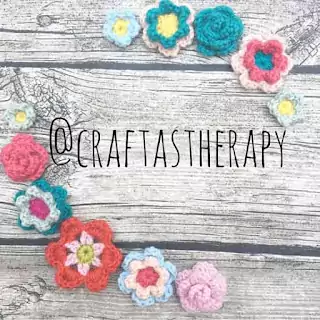Many hospitals, care facilities, and therapy programs are now incorporating art, craft and music therapy as part of their treatment programs. As an example, St. Boniface General Hospital McEwan Psychiatric Centre in Winnipeg, Canada, has a hands-on clay/ceramic therapy it does with patients. Clients are able to form tiles, or shapes, have them fired, then painted and re-fired, to be added to the centre’s front garden at the main entrance. Doing this provides a creative outlet for patients with differing abilities – no experience is required, and even the most affected by psychiatric disorders are able to manipulate the clay. Creating the tiles provides an opportunity to follow a project to completion, with a subsequent feeling of accomplishment and value. Patients take pride in pointing out their completed projects in the garden – it is proof of their worth and value, something that is often missing in the lives of patients with mood disorders.
Healing, stitch by stitch
When Susanna* (not her real name) was hospitalized following a suicide attempt last fall, she suddenly found she had a lot of time on her hands. “I needed something to keep busy. I was allowed out for walks on the grounds, but much of my time was spent reading or staring out the window.” Susanna asked if she could have her spouse bring a craft project – some knitting needles and yarn for her to work on. After it was determined she was no longer a danger to herself, or others, she received permission for her craft supplies to come to hospital. “It gave me something tangible to do, something physical to hold on to. And it was a great analogy – as I was knitting the sweater, I felt like I was knitting my life back together…”
Author Nancy Monson’s book Craft to Heal: Soothing Your Soul with Sewing, Painting, and Other Pastimes explores in further detail the physical, psychological and spritual healing effect of creation. In her introduction, Heather discusses the therapeutic benefit she herself received from creating her first art quilt, and the response she had from others when she shared her creation at a quilt guild show. As Nancy says in her introduction “All we need is permission from ourselves to spend time creating and the courage to push beyond our comfort zone so our projects truly express what’s inside and help us to unblock, purge, and transform our feelings.”
Stitching and B*tching…
Participating in crafts or art therapy can also assist those with mood disorders by providing a social network and staving off isolation. A simple knitting class teaches the basics, while giving the client an opportunity for social interaction outside of their daily worries. With this in mind, the Plano, TX group “WHAT Knots!” meets regularly, for group knitting or crochet sessions. The WHAT Nots! founder, Kristie Miller, promotes the group projects as a great way to relax and de-stress, a means of escape from daily pressure and troubles. The group has been in existence for a little over three years and meets 3 to 4 times a week. “I love, love, love teaching!” says Kristie. “It is very rewarding to teach someone a new skill that helps them to relax and escape their everyday worries. I have had more than a few clients share their personal issues with the group and how the knitting/crocheting has helped them through their problems and gave them the outlet they needed to feel better. I know that it has become a daily part of my life for that very same reason.”
Creating a project of any kind requires sustained attentiveness, and assists in re-development of concentration and memory. “I found I was able to let my mind wander, but only so much. I couldn’t ‘space out’ or I would make a mistake in the pattern. It really helped me with my attention span,” said Susanna. Choosing the materials or colors for a project, allows the person creative expression and a sense of control, at a time when their lives may feel out of control. Completion of a project, whether large like a sweater, or small like a bracelet, gives the participant a sense of pride and achievement.
“It’s not all about me…”
Participating in an art or craft group allows the patient to step away from their mood disorder, even if for a short while. The conversation can drift away from the patient’s specific mood, to instructions on the craft, and back again. Those that want to focus on the activity alone have the opportunity to refrain from discussion, but still have the companionship of fellow crafters. They, and their mood disorder, are no longer in the main spotlight – the artwork or craft project is the central focus.
Craft groups can also allow for participants to give back to their community in a small way. Small projects such as jewelry, mittens, scarves and hats, can be donated to local charities or used as fundraisers. Larger projects such as quilts or blankets can be assembled and given to group members.
Incorporating art and/or craft therapy into patient treatment is an idea which has growing support. Whether explored independently or in a group setting, it can become a great adjunct to traditional therapies for depression and other mood disorders.
